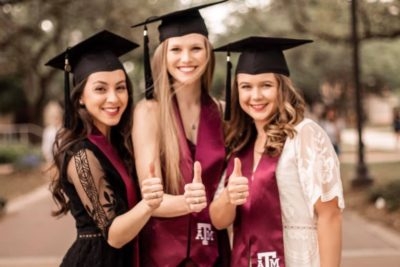COLLEGE STATION. The Texas A&M campus is huge. It has to be. It’s also mystifying on most days. On graduation day it can be downright overwhelming. Literal thousands graduate every May. This year, eight ceremonies were held over three days. Three ceremonies on Wednesday. Three on Thursday. Two on Friday.
Our oldest grandchild, Shelby, graduated in the third ceremony on the second day.
If you are a longtime reader, you’ll remember I first mentioned her in AmericanGenerations_4Shelby. Back then she was an 8-year-old gymnast. She was part of a series that tracked technical and social change through four generations of a family – my family.
You might also have read about her in 2015. That’s when she left for A&M driving the 2003 Prius we had given her when she got her driver’s license two years earlier. Back then the Prius had about 123,000 miles on it.
Today, having survived two years of high school driving and four years trekking between Flower Mound and College Station, the Prius has covered a tad over 171,000 miles. It’s still going strong, even if its looks are a bit on the quaint side. Today the Prius is so much part of the family it’s called Edna.
I could tell you a lot about the world of worry Shelby and the class of 2019 face. The list is all too familiar. But we’d be missing something really important: Women like her have blown open the door to a vast store of human capital.
How vast? Think half the human race. Actually, a bit more since there are more women than men. Educated young women are breaking out of the role gulag women have historically faced. Sure, they can be teachers, nurses and support personnel. But they can also do just about anything they want.
Shelby is a good case in point. Entering A&M, she thought she would train to be a middle school math teacher. I thought it was a great idea, given the shortage of STEM teachers. But her interest in math was strong enough (not to mention her talent) that she was urged to switch her major from education to math, graduating in applied mathematics and computer science.
Tall, blonde and captain of her high school cheerleading team, she’s a major challenge to the stereotype math nerd or science geek.
Last summer she interned at a North Texas high tech firm that can put her talent to good use. Soon, she’ll be starting as a full-time employee there.
What will she be doing? I don’t know. She can’t tell me. It’s secret.
But that’s OK. The important thing is the development and use of human potential. That’s what happened for Shelby and more than 10,000 students in her class at A&M. And, noisy rivalry notwithstanding, it’s what happens for a similar number of students at the University of Texas. (Yes, we’ve got a grandchild at UT, too. I believe in balanced, even-handed education.) Every year, both of these amazing institutions build the human capital of Texas.
That capital — more than cash, more than loans, more than conventional investment — is what makes things happen. Without it, we wither. That’s what University of Texas Chancellor, James B. Milliken, told Chancellor’s Council members only a few weeks ago. With a population expected to double by 2050, Texas can’t mess around.
This makes Shelby – and all the women in her graduating class – really important.
Unfortunately, we pay more attention to financial capital than human capital. In fact, the value of human capital dwarfs the value of financial capital.
Yes, I know: That’s hard to believe. With new stock market records being set on a regular basis and with new companies going public at extraordinary mega-billion valuations, it seems to be all about the conventional money.
But it’s not.
Here’s some perspective. The total market value of all publicly traded domestic stocks, as represented by the Wilshire 5000 index, recently hit $30 trillion. That’s about 1.4 times our gross domestic product.
Human capital isn’t measured by checking a stock exchange. It’s measured by academic studies. But the most recent estimate that I’ve found, from 2016, put the value of human capital at 14.28 times gross domestic product.
So do the math. In America, our human capital is worth 10 times as much as our market capital.
Let’s keep those caps and tassels flying.
Related columns:
Scott Burns, “The Prius Solution: Take a deep breath,” 5/13/04 https://scottburns.com/the-prius-solution-take-a-deep-breath/
Scott Burns, “Three Years of Prius,” 4/30/2006 https://scottburns.com/three-years-of-prius/
Scott Burns, “Prius at Five,” 4/25/08 https://scottburns.com/prius-at-five/
Scott Burns, “Prius at 8,” 5/06/11 https://scottburns.com/our-prius-at-8/
Scott Burns, “Prius at ten,” 5/12/13 https://scottburns.com/prius-at-10/
Scott Burns, “Prius goes to college,” 8/21/15 https://scottburns.com/prius-goes-to-college/
(1) Scott Burns, “American Generations: the story of four family members’ search for security in an ever-changing America,” 10/28/05
Sources and References:
St. Louis Federal Reserve Bank: U.S. Total Stock Market Value (Wilshire 5000 index) https://fred.stlouisfed.org/series/WILL5000PRFC
Michael S. Christian, “Net Investment and Stocks of Human Capital in the United States, 1975-2013,” 1/4/2016 https://www.bea.gov/system/files/papers/WP2016-1.pdf
Chancellor’s Council Meeting, April 26, 2019 https://advancing.utsystem.edu/ccam2019-recap
This information is distributed for education purposes, and it is not to be construed as an offer, solicitation, recommendation, or endorsement of any particular security, product, or service.
Photo: Lindsey Perryman/Lensey Photography
(c) Scott Burns, 2019
1 thought on “Mathematically Blonde”
Comments are closed.

Hi Scott! I have missed you and so glad you are back!
I am enjoying your retirement journey in Texas, thank you for expert advise, your the best!